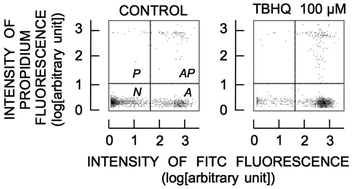当前位置:
X-MOL 学术
›
Toxicol. Res.
›
论文详情
Our official English website, www.x-mol.net, welcomes your
feedback! (Note: you will need to create a separate account there.)
Diverse cellular actions of tert-butylhydroquinone, a food additive, on rat thymocytes
Toxicology Research ( IF 2.2 ) Pub Date : 2017-09-26 00:00:00 , DOI: 10.1039/c7tx00183e Norio Kamemura 1, 2, 3, 4 , Keisuke Oyama 4, 5, 6 , Kaori Kanemaru 1, 2, 3, 4 , Kumio Yokoigawa 1, 2, 3, 4 , Yasuo Oyama 1, 2, 3, 4
Toxicology Research ( IF 2.2 ) Pub Date : 2017-09-26 00:00:00 , DOI: 10.1039/c7tx00183e Norio Kamemura 1, 2, 3, 4 , Keisuke Oyama 4, 5, 6 , Kaori Kanemaru 1, 2, 3, 4 , Kumio Yokoigawa 1, 2, 3, 4 , Yasuo Oyama 1, 2, 3, 4
Affiliation

|
Tertiary butylhydroquinone (TBHQ) is a food additive that possesses antioxidant activity. Its alternative applications have been explored in recent studies. However, there is controversy regarding safety. In this study using rat thymocytes, the cellular actions of TBHQ at sublethal concentrations were examined. TBHQ at concentrations of 3 μM or more elevated intracellular Zn2+ concentration ([Zn2+]i) in a dose-dependent manner, by increasing membrane Zn2+ permeability and releasing Zn2+ from cellular stores. TBHQ at 30 μM significantly increased side scatter (cell density) and the exposure of phosphatidylserine (PS) on cell membrane surfaces. It also decreased cellular glutathione (GSH) content without affecting cell lethality. Forward scatter was attenuated by 100 μM TBHQ. Thus, it is considered that TBHQ at sublethal concentrations (30 μM or less) exerts some adverse actions on cells. TBHQ at 10–30 μM attenuated the increase in cell lethality induced by hydrogen peroxide (H2O2), while potentiation of H2O2 cytotoxicity by 100 μM TBHQ was observed. The range of concentrations of TBHQ from benefit to toxicity under in vitro conditions may be 10–30 μM. Although TBHQ exhibits antioxidative actions at concentrations that are lower than those which elicit adverse cellular effects, sublethal levels of TBHQ cause some adverse actions that may be clinically concerned.
中文翻译:

食品添加剂叔丁基对苯二酚对大鼠胸腺细胞的不同细胞作用
叔丁基氢醌(TBHQ)是具有抗氧化活性的食品添加剂。在最近的研究中已经探索了它的替代应用。但是,关于安全性存在争议。在这项使用大鼠胸腺细胞的研究中,研究了TBHQ在亚致死浓度下的细胞作用。通过增加膜Zn 2+的渗透性和释放Zn 2 +, TBHQ在3μM或更高浓度下以剂量依赖的方式升高的细胞内Zn 2+浓度([Zn 2+ ] i)从手机店。浓度为30μM的TBHQ显着增加了侧面散射(细胞密度)和磷脂酰丝氨酸(PS)在细胞膜表面的暴露。它也减少了细胞谷胱甘肽(GSH)的含量,而不会影响细胞的致死性。前向散射被100μMTBHQ衰减。因此,认为亚致死浓度(30μM或更小)下的TBHQ对细胞产生一些不利作用。10–30μM的TBHQ减弱了过氧化氢(H 2 O 2)诱导的细胞杀伤力的增加,同时观察到100μMTBHQ增强了H 2 O 2的细胞毒性。在体外,从有益到毒性的TBHQ浓度范围条件可能是10–30μM。尽管TBHQ在低于引起不利细胞作用的浓度下会表现出抗氧化作用,但是TBHQ的亚致死水平会引起一些可能在临床上引起关注的不良作用。
更新日期:2017-10-30
中文翻译:

食品添加剂叔丁基对苯二酚对大鼠胸腺细胞的不同细胞作用
叔丁基氢醌(TBHQ)是具有抗氧化活性的食品添加剂。在最近的研究中已经探索了它的替代应用。但是,关于安全性存在争议。在这项使用大鼠胸腺细胞的研究中,研究了TBHQ在亚致死浓度下的细胞作用。通过增加膜Zn 2+的渗透性和释放Zn 2 +, TBHQ在3μM或更高浓度下以剂量依赖的方式升高的细胞内Zn 2+浓度([Zn 2+ ] i)从手机店。浓度为30μM的TBHQ显着增加了侧面散射(细胞密度)和磷脂酰丝氨酸(PS)在细胞膜表面的暴露。它也减少了细胞谷胱甘肽(GSH)的含量,而不会影响细胞的致死性。前向散射被100μMTBHQ衰减。因此,认为亚致死浓度(30μM或更小)下的TBHQ对细胞产生一些不利作用。10–30μM的TBHQ减弱了过氧化氢(H 2 O 2)诱导的细胞杀伤力的增加,同时观察到100μMTBHQ增强了H 2 O 2的细胞毒性。在体外,从有益到毒性的TBHQ浓度范围条件可能是10–30μM。尽管TBHQ在低于引起不利细胞作用的浓度下会表现出抗氧化作用,但是TBHQ的亚致死水平会引起一些可能在临床上引起关注的不良作用。










































 京公网安备 11010802027423号
京公网安备 11010802027423号